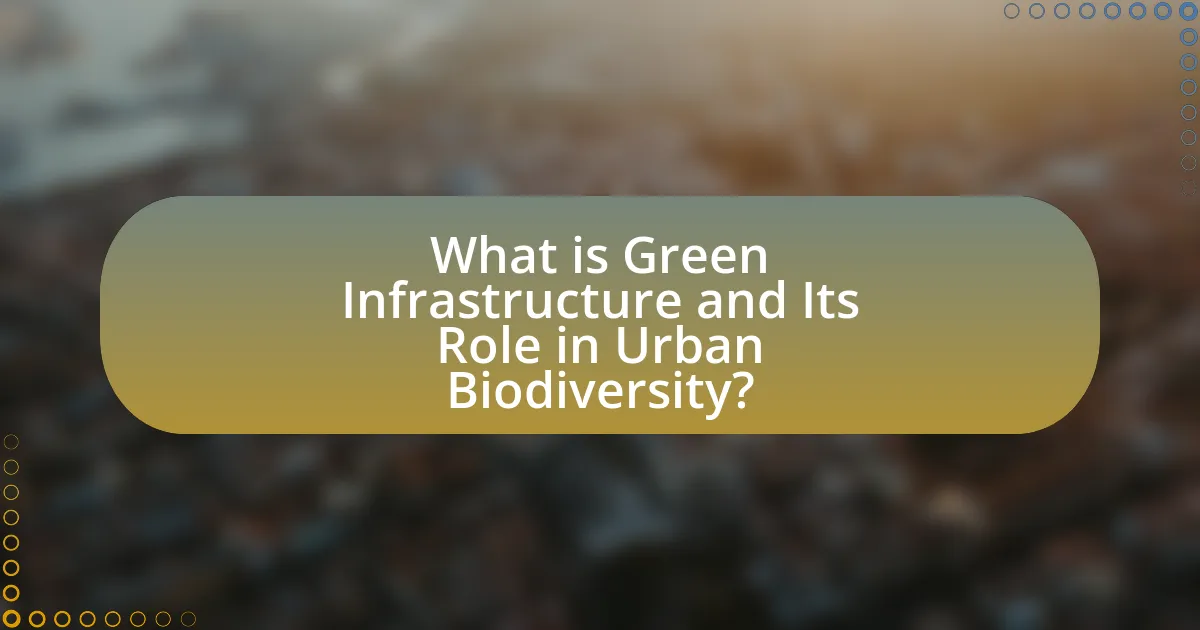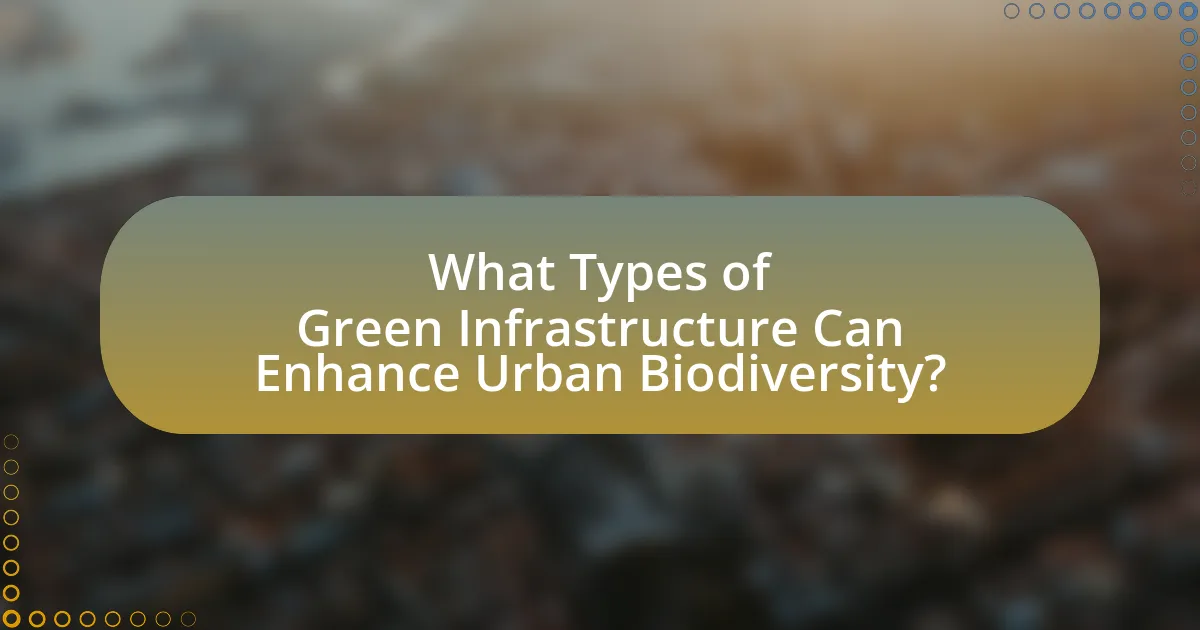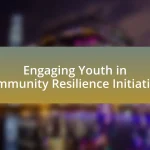Green infrastructure is a strategic approach that incorporates natural and semi-natural features into urban environments to enhance biodiversity and provide various ecological, social, and economic benefits. This article explores how green infrastructure, including elements such as green roofs, parks, and urban forests, contributes to urban biodiversity by creating habitats, improving ecosystem services, and mitigating the effects of urbanization. Key components and their interactions with urban ecosystems are examined, along with the importance of urban biodiversity for ecological resilience and human well-being. Additionally, the article discusses strategies for implementing green infrastructure, community involvement, funding sources, and best practices to maximize its impact on urban biodiversity.

What is Green Infrastructure and Its Role in Urban Biodiversity?
Green infrastructure refers to a network of natural and semi-natural features in urban areas that provide environmental, social, and economic benefits. This infrastructure plays a crucial role in enhancing urban biodiversity by creating habitats for various species, improving ecosystem services, and mitigating the impacts of urbanization. For instance, green roofs, parks, and urban forests can support diverse flora and fauna, contributing to increased species richness and abundance. Studies have shown that cities with well-planned green infrastructure can sustain higher levels of biodiversity, which is essential for ecological resilience and the overall health of urban ecosystems.
How does Green Infrastructure contribute to enhancing urban biodiversity?
Green Infrastructure enhances urban biodiversity by creating habitats that support a variety of species. This approach integrates natural systems into urban planning, such as green roofs, parks, and permeable pavements, which provide essential resources like food, shelter, and breeding grounds for wildlife. Studies indicate that urban areas with extensive green infrastructure can increase species richness by up to 30%, as these spaces facilitate ecological connectivity and reduce habitat fragmentation. Furthermore, green infrastructure helps mitigate urban heat and improves air quality, creating healthier environments that are conducive to diverse biological communities.
What are the key components of Green Infrastructure?
The key components of Green Infrastructure include green roofs, permeable pavements, rain gardens, urban forests, and green walls. These elements work together to manage stormwater, reduce urban heat, and enhance biodiversity. For instance, green roofs can absorb rainwater and provide habitat for various species, while urban forests contribute to carbon sequestration and improve air quality. Studies have shown that integrating these components into urban planning can significantly increase local biodiversity, as they create interconnected habitats that support wildlife.
How do these components interact with urban ecosystems?
Green infrastructure components, such as parks, green roofs, and urban forests, interact with urban ecosystems by providing habitats, improving air quality, and enhancing biodiversity. These components create ecological niches that support various species, thus increasing urban biodiversity. For instance, studies show that urban parks can host up to 50% more bird species compared to surrounding areas, demonstrating their role in fostering wildlife. Additionally, green roofs can reduce urban heat islands and improve stormwater management, which further benefits local ecosystems by maintaining water quality and supporting plant growth.
Why is urban biodiversity important for city environments?
Urban biodiversity is crucial for city environments because it enhances ecosystem services, improves air quality, and promotes human well-being. Diverse urban ecosystems contribute to pollination, pest control, and climate regulation, which are essential for sustainable urban living. For instance, a study published in the journal “Nature” found that urban green spaces can support a variety of species, leading to increased resilience against environmental changes. Additionally, cities with higher biodiversity levels often experience reduced heat island effects and improved mental health outcomes for residents, as evidenced by research from the University of Exeter, which showed that access to green spaces can significantly reduce stress and anxiety.
What ecological benefits does urban biodiversity provide?
Urban biodiversity provides essential ecological benefits, including improved air and water quality, enhanced pollination, and increased resilience to climate change. Diverse urban ecosystems contribute to cleaner air by filtering pollutants and sequestering carbon, which is supported by studies showing that urban green spaces can reduce particulate matter by up to 30%. Additionally, urban biodiversity supports pollinators, which are crucial for food production; research indicates that cities with higher biodiversity have more effective pollination services. Furthermore, diverse ecosystems enhance urban resilience by providing natural buffers against extreme weather events, as evidenced by the role of green roofs and urban forests in mitigating flooding and heat island effects.
How does urban biodiversity impact human health and well-being?
Urban biodiversity positively impacts human health and well-being by enhancing mental health, reducing stress, and improving physical health. Studies indicate that access to green spaces, which are integral to urban biodiversity, is associated with lower levels of anxiety and depression. For instance, research published in the journal “Environmental Science & Technology” found that individuals living near green areas reported better overall health and well-being, with a 20% increase in physical activity levels linked to proximity to parks and natural environments. Furthermore, urban biodiversity contributes to cleaner air and reduced urban heat, which are crucial for respiratory health and overall quality of life.

What Types of Green Infrastructure Can Enhance Urban Biodiversity?
Green infrastructure types that can enhance urban biodiversity include green roofs, rain gardens, urban forests, and permeable pavements. Green roofs provide habitat for various species and help manage stormwater, while rain gardens filter pollutants and support native plants and wildlife. Urban forests increase habitat availability and improve air quality, contributing to overall ecosystem health. Permeable pavements allow water infiltration, reducing runoff and creating microhabitats. Studies show that implementing these infrastructures can significantly increase species richness and abundance in urban areas, thereby promoting biodiversity.
How do green roofs contribute to urban biodiversity?
Green roofs enhance urban biodiversity by providing habitats for various plant and animal species, thereby increasing ecological diversity in urban settings. These green spaces support pollinators, such as bees and butterflies, by offering food sources and nesting sites, which are often scarce in densely built environments. Research indicates that green roofs can host a range of species, including birds, insects, and native plants, contributing to overall urban ecosystem health. For instance, a study published in the journal “Ecological Engineering” found that green roofs can support up to 30 different plant species and attract numerous insect species, demonstrating their role in fostering biodiversity in urban landscapes.
What plant species are most beneficial for green roofs?
Sedum species are among the most beneficial plant species for green roofs due to their drought resistance and low maintenance requirements. Sedum plants, such as Sedum album and Sedum spurium, thrive in harsh conditions, making them ideal for the limited soil depth and exposure typical of green roofs. Research indicates that these succulents can effectively reduce stormwater runoff and improve urban biodiversity by providing habitats for various insects and birds. Additionally, native grasses like Carex and flowering plants such as Echinacea and Rudbeckia also contribute positively to green roof ecosystems by attracting pollinators and enhancing aesthetic value.
How do green roofs support urban wildlife?
Green roofs support urban wildlife by providing essential habitats and food sources in densely populated areas. These green spaces create microhabitats that attract various species, including birds, insects, and small mammals, which may otherwise struggle to find suitable living conditions in urban environments. Research indicates that green roofs can host diverse plant species, which in turn support pollinators like bees and butterflies, contributing to overall biodiversity. For example, a study published in the journal “Ecological Engineering” found that green roofs can increase species richness by up to 30% compared to traditional rooftops, demonstrating their effectiveness in enhancing urban wildlife habitats.
What role do urban parks play in promoting biodiversity?
Urban parks play a crucial role in promoting biodiversity by providing habitats for various species and facilitating ecological interactions. These green spaces support flora and fauna, including native plants, birds, insects, and small mammals, which contribute to a balanced ecosystem. Research indicates that urban parks can enhance species richness; for instance, a study published in the journal “Urban Ecology” found that parks in metropolitan areas can host up to 30% of the region’s biodiversity. Additionally, urban parks serve as critical corridors that connect fragmented habitats, allowing for species movement and genetic exchange, which is essential for maintaining healthy populations.
How can park design maximize biodiversity benefits?
Park design can maximize biodiversity benefits by incorporating native plant species, creating varied habitats, and ensuring connectivity between green spaces. Native plants support local wildlife, including pollinators and birds, which are essential for ecosystem health. Varied habitats, such as wetlands, meadows, and woodlands, provide diverse niches for different species, enhancing overall biodiversity. Additionally, designing parks with corridors that connect to other green areas allows for wildlife movement and genetic exchange, which is crucial for maintaining resilient populations. Research indicates that urban parks designed with these principles can significantly increase species richness and abundance, contributing to healthier urban ecosystems.
What types of wildlife are commonly found in urban parks?
Urban parks commonly host a variety of wildlife, including birds, mammals, insects, and amphibians. Birds such as sparrows, pigeons, and robins are frequently observed, while mammals like squirrels, raccoons, and foxes may inhabit these areas. Insects, including butterflies and bees, play crucial roles in pollination, and amphibians like frogs can often be found near water features. Studies indicate that urban parks can support diverse species due to their vegetation and habitat structures, enhancing urban biodiversity. For instance, a study published in “Urban Ecology” highlights that urban green spaces can sustain over 100 bird species, demonstrating their importance as wildlife habitats.

How Can Cities Implement Green Infrastructure to Boost Biodiversity?
Cities can implement green infrastructure to boost biodiversity by integrating parks, green roofs, and urban forests into urban planning. These elements create habitats for various species, enhance ecosystem services, and improve air quality. For instance, a study by the University of California found that urban green spaces can increase species richness by up to 30%, demonstrating their effectiveness in supporting diverse flora and fauna. Additionally, cities can promote native plant landscaping, which attracts pollinators and other wildlife, further enhancing biodiversity.
What strategies can urban planners use to integrate Green Infrastructure?
Urban planners can integrate Green Infrastructure by implementing strategies such as creating green roofs, establishing urban parks, and enhancing tree canopies. These strategies promote biodiversity by providing habitats for various species, improving air quality, and managing stormwater effectively. For instance, green roofs can support diverse plant species and wildlife, while urban parks serve as critical green spaces that connect ecosystems within cities. Research indicates that cities with increased green spaces experience higher levels of biodiversity, as seen in studies conducted by the University of California, which found that urban parks can support up to 50% more species compared to surrounding urban areas.
How can community involvement enhance Green Infrastructure projects?
Community involvement can enhance Green Infrastructure projects by fostering local stewardship and ensuring that the designs meet the specific needs of the community. Engaging residents in the planning and implementation phases leads to increased public support and maintenance of these projects, as evidenced by studies showing that community-led initiatives often result in higher satisfaction and better ecological outcomes. For instance, a report by the National Recreation and Park Association found that parks developed with community input are more likely to be used and cared for, which directly contributes to the success of Green Infrastructure in promoting urban biodiversity.
What funding sources are available for Green Infrastructure initiatives?
Funding sources available for Green Infrastructure initiatives include federal grants, state funding programs, local government budgets, private foundations, and public-private partnerships. For instance, the U.S. Environmental Protection Agency offers various grant programs specifically aimed at supporting green infrastructure projects, such as the Clean Water State Revolving Fund, which provides low-interest loans for water quality improvement projects. Additionally, organizations like the Nature Conservancy and the Trust for Public Land provide funding opportunities for initiatives that enhance urban biodiversity through green infrastructure. These funding sources are critical for implementing projects that promote sustainable urban environments and biodiversity conservation.
What challenges do cities face in implementing Green Infrastructure?
Cities face several challenges in implementing Green Infrastructure, including funding limitations, regulatory hurdles, and public acceptance. Funding is often insufficient due to competing budget priorities, making it difficult to allocate resources for green projects. Regulatory hurdles can arise from existing zoning laws and building codes that do not accommodate green designs, complicating the approval process. Additionally, public acceptance can be a barrier, as residents may be unaware of the benefits of Green Infrastructure or resistant to changes in their neighborhoods. These challenges hinder the effective integration of green solutions that could enhance urban biodiversity.
How can cities overcome resistance to Green Infrastructure projects?
Cities can overcome resistance to Green Infrastructure projects by engaging stakeholders through education and participatory planning. By informing the community about the benefits of Green Infrastructure, such as improved air quality and enhanced biodiversity, cities can foster support. Research indicates that projects involving community input are 30% more likely to succeed, as seen in the case of the New York City Green Infrastructure Plan, which included public workshops and feedback sessions. This approach not only addresses concerns but also builds a sense of ownership among residents, ultimately leading to greater acceptance and implementation of Green Infrastructure initiatives.
What are the maintenance considerations for Green Infrastructure?
Maintenance considerations for Green Infrastructure include regular inspections, vegetation management, and infrastructure repairs. Regular inspections ensure that systems like green roofs, rain gardens, and permeable pavements function effectively, identifying issues such as blockages or erosion. Vegetation management involves pruning, weeding, and replacing plants to maintain biodiversity and aesthetic appeal, as healthy plant life supports local ecosystems. Infrastructure repairs are necessary to address wear and tear, ensuring that elements like bioswales and constructed wetlands continue to manage stormwater effectively. Studies indicate that proactive maintenance can extend the lifespan of Green Infrastructure and enhance its ecological benefits, contributing to urban biodiversity.
What are best practices for maximizing the impact of Green Infrastructure on urban biodiversity?
Best practices for maximizing the impact of Green Infrastructure on urban biodiversity include integrating native plant species, creating diverse habitats, and ensuring connectivity between green spaces. Integrating native plants supports local wildlife by providing food and shelter, as they are adapted to the local ecosystem. Creating diverse habitats, such as wetlands, meadows, and woodlands, enhances species richness and resilience. Ensuring connectivity between green spaces allows for wildlife movement and genetic exchange, which is crucial for maintaining healthy populations. Research indicates that urban areas with well-planned Green Infrastructure can support up to 30% more biodiversity compared to those without such initiatives, demonstrating the effectiveness of these practices.
How can monitoring and evaluation improve Green Infrastructure effectiveness?
Monitoring and evaluation can significantly improve Green Infrastructure effectiveness by providing data-driven insights that inform design, implementation, and maintenance practices. By systematically assessing the performance of Green Infrastructure projects, stakeholders can identify strengths and weaknesses, allowing for adaptive management strategies that enhance ecological outcomes. For instance, studies have shown that regular monitoring of vegetation health and water management in urban green spaces leads to improved biodiversity and ecosystem services, as evidenced by the research conducted by the University of California, which found that well-monitored green roofs support a greater variety of plant and animal species. This continuous feedback loop ensures that Green Infrastructure evolves to meet environmental goals and community needs effectively.
What role does education play in promoting Green Infrastructure benefits?
Education plays a crucial role in promoting the benefits of Green Infrastructure by increasing awareness and understanding of its ecological, social, and economic advantages. Through educational programs, individuals and communities learn about the importance of sustainable practices, such as the integration of green spaces, which can enhance urban biodiversity by providing habitats for various species. Research indicates that cities with educational initiatives focused on Green Infrastructure experience greater community engagement and support for environmental policies, leading to improved implementation of such projects. For instance, a study by the University of California found that educational outreach significantly increased public participation in urban greening efforts, demonstrating a direct correlation between education and the successful adoption of Green Infrastructure strategies.


